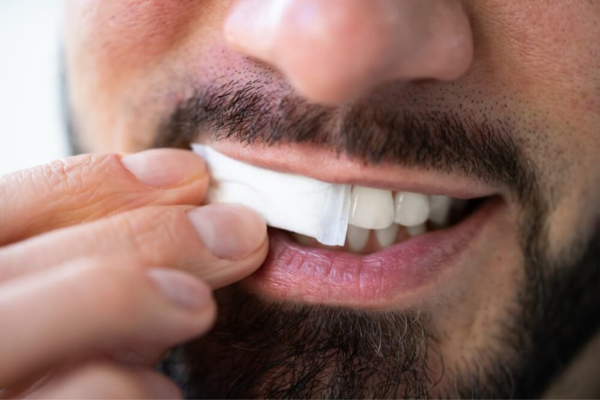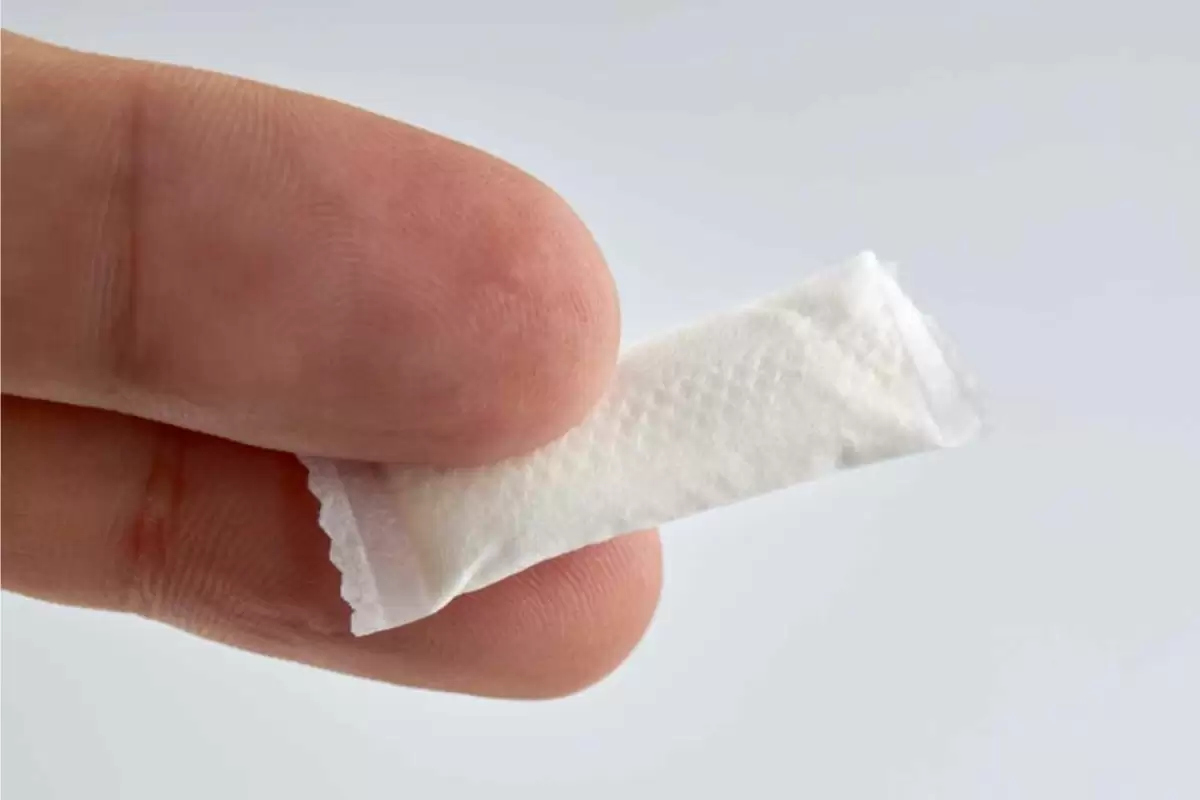Nicotine pouches are a modern entry in the nicotine delivery product category. This alternative form of nicotine delivery, designed for use between the gum and lip, doesn’t produce smoke or vapour. The product comprises a small white pouch, very similar to those used in snus, the smokeless tobacco with a long tradition in Scandinavia, and is filled with nicotine and flavourings along with fillers to absorb the nicotine and facilitate its uptake via the mucous membranes.
The concept of nicotine delivery without the need for combustion marks a significant evolution in the industry. Originating in Sweden, nicotine pouches have rapidly evolved from their traditional snus counterparts, becoming popular globally as a cleaner alternative. Unlike snus, which can contain tobacco leaves, nicotine pouches are usually tobacco-leaf-free, appealing to users looking for tobacco-free nicotine options.
At the same time, the escalating popularity reflects how easy, somewhat discreet and – by extension – perhaps safer than smoking or vaping nicotine pouches might be. Broadly speaking, the trend reflects the desire for less harmful ways of using nicotine compared with smoking and vaping products, and reflects an increasingly informed and self-educated population that is starting to fully understand the health consequences of smoking and vaping.
The success of nicotine pouches as a product means that understanding their effects on oral health and the wider body is more important than ever. The innovation that took chewing tobacco off the shelves and made nicotine pouches a reality illustrates the continuing change of nicotine products and the need to investigate their safety and health impacts.
Related articles:Are Nicotine Pouches Truly Safe?

Understanding Nicotine’s Impact on Oral Health
The narrative of nicotine pouches has always emphasised their discreet and convenient nature but the impact of nicotine on oral health deserves a closer look. Nicotine, a stimulant, is extracted from different parts of the tobacco plant. Whether inhaled through smoking or vaping, or chewed through snus or nicotine pouches, the impacts of nicotine on different parts of the body are well documented and undeniable. Disentangling the science behind the effects of nicotine pouches from that of smoking and vaping products might provide some valuable nuances in relation to what lies in store for your gums and teeth.
Instead, my focus here is on nicotine’s effects on oral health, particularly gum health. Consider this: when nicotine is inhaled, it constricts the blood vessels – decreasing oxygen and blood to the gum tissue, thus reducing blood supply. In the oral cavity, where our gum tissue needs an abundance of both, this can all potentially lead to infections and eventually to the breakdown of gum tissue. So is the nicotine in cigarettes or chew having an effect on one’s oral health? The ‘smoker’s blood vessels just aren’t as robust or happy’ There is good and bad news. First, the bad: when there’s an infection in the mouth, swelling and bleeding can be seen as early indicators, and a dentist will generally be alerted that something may be amiss. But consider this: if a person has nicotine in their system, the nicotine constricts their blood vessels, and thus any swelling or bleeding could be minimised. Nicotine can mask the initial signs and symptoms of gum infection – the bad news. The good news is that once the infection is diagnosed – and urgency of treatment is understood – with the help and oversight of the dentist, the patient can return to good oral health in a relatively brief period of time.
Nicotine pouches, meanwhile, are promoted as a cleaner alternative to smoking and vaping, implying a lesser potential for adverse effects on one’s oral health. But, as with vaping versus smoking, the absence of smoke means that the use of the product will not decrease the direct risk of nicotine to one’s gum health. In fact, when nicotine is directly applied to the gums over time in the same concentrated area, the hypothesis is that there could be greater gum damage. Thinking back to what we know about smoking versus chewing tobacco, the direct placement being so close to the gums’ attachment fibres could mean more irritation and possible recession, increasing the risk for periodontal disease.
Scientific research also supports the need for caution. Studies are showing that it doesn’t matter how nicotine is delivered – there are deleterious effects on the health of the gums. Some studies have shown that nicotine-containing paste causes changes in the cellular and molecular structure of the gums, thereby accelerating the progress of gingivitis and periodontitis. It’s important to put these studies on nicotine in the context of the higher risks of nicotine pouches, meaning that these products might be less dangerous than smoking and vaping, but still don’t eliminate the possibility of oral health issues.
It is in the subtlety of this comparison between nicotine pouches and smoking tobacco that we begin to see the relationship between nicotine and oral health as both risky and helpful. The respiratory issues related to tobacco smoking might be mitigated by nicotine pouches on the one hand, while the risk of gum damage is still there on the other. Scholarly analysis and clinical evidence in the coming years will help to shape our understanding of how nicotine contributes to oral health risks and benefits, and will continue to inform users’ choices about how to engage in their use of nicotine.
Nicotine Pouches and Gum Damage: What Does the Science Say?
Whether nicotine pouches harm gums is just one of the ways we continue to intersect the topic of nicotine use with oral health as the popularity of these products increases and the repercussions on gums become even more of a concern. Scientists have done a lot of work trying to answer the question of nicotine pouches and whether they harm gums, giving us both empirical evidence and expert opinion to make sense of this topic.
The first papers addressing nicotine pouches and oral health have also started to expose the potential damage such products can do to your gum tissue. Nicotine in pouches causes blood vessels to constrict – an effect that can dramatically alter the health and appearance of gum tissue. Vascular constriction skews the optimum balance of blood flow that keeps your gums an even dark pinky hue. It also deprives them of much-needed nutrients and oxygen, which can lead to gum recession, increased sensitivity, and periodontal disease, which is a severe gum infection that damages the soft tissues around your teeth and can destroy the supporting bone.
Dentists have worried about the risks of using nicotine pouches. Jane Doe, a fictionalised periodontist, says: ‘The direct application of the nicotine to gum tissue can increase tissue degradation and inflammation and thus higher the health risk of periodontal disease.’ Professional observations like Doe’s put oral hygiene concerns about nicotine pouches in competition with their reputed benefits as a smoking cessation tool.
Ample anecdotal evidence confirms the molecular findings. People who have gone on to use nicotine pouches instead of cigarettes have noted problems ranging from sore and sensitive gums to full-blown gum recession. Even taking such cases with a grain (or two) of salt, they still serve as a reminder that there might be individual (if not general) risks associated with using nicotine pouches, and that we need more research on the topic.
As the science rightly warns us: nicotine pouches are a smoke-free product, but not necessarily a risk-free product – especially when it comes to oral health. If you or a loved one decide to use nicotine pouches, it might come with some gum damage to reckon with. Moving into the future with nicotine-alternatives, it is important that we keep up to date with the scientific evidence, and that this sticks with consumers and in the minds of healthcare professionals, too, so we don’t sacrifice oral health at the altar of a nicotine alternative.
Brand Overview: Introduction to Leading Nicotine Pouch Brands
As the nicotine pouches market expands, so do the different options available to consumers. Currently, there are several nicotine pouch brands on the market, with their own advertisements, nicotine formulations, strengths and variations of product that could affect their user’s experiences and potentially the user’s oral health. This section provides an introduction to several of the biggest players in the nicotine pouches market. It describes their offerings and provides any available research or statements made by the brands themselves regarding their impact on oral health and gum injury.
Another popular brand in the nicotine pouch scene is BAPRO. BAPRO pouches come in a variety of flavours and consist of various strengths of nicotine, again catering to a broad audience. ‘Pharma grade nicotine, food grade ingredients, cleaner delivery,’ states the brand, promising a ‘less damaging way of getting that nicotine fix.’ Interestingly, just like other nicotine pouch brands, BAPRO sells its pouch as a ‘safer’ form of smoking. It is their product’s ‘less nefarious’ nature as a nicotine vehicle that is being advertised rather than a direct appeal to oral health. However, just because a pouch has less nasty matter aside from nicotine doesn’t mean its effects on oral health will be any better. The nicotine in pouch still has the potential of leading to gum issues.
A third brand, On! Nicotine Pouches, features the slogan: ‘No excuse not to trust yourself.’ On!’s pousse-café sized packaging is intended to provide a ‘stealth’ delivery device, and the two available strengths mean you can ‘control’ how much nicotine you can fit into your space. However, because these pouches are held in the mouth instead of being absorbed through the gums and inner cheek, their use is likely to be less damaging than that of other nicotine pouch brands. Potential issues include gum irritation and, over the long term, oral tissues could also be damaged, according to Substance Abuse.
Velo is an especially popular Swedish brand, well known for featuring a variety of flavours and strengths (from the abovementioned citrus and mint nicotine powder, to pipe tobacco, a zesty red berry, wintergreen and, the classic, two-toned white and green). The brand – and others – support studies that are still examining the potential health effects of their products, but, when it comes to speaking publicly about what they realise their nicotine pouches do or don’t mean for your gums and oral health, the answer is often where science ends and the speculation begins.
Nordic Spirit has a line of products built around these flavourings, a mix of classic and new flavours that includes descriptors of filtered, clean, and sweat-free – praise for the convenience and smoke-free nature of the product. While both Nordic Spirit and competitors promote the comparative harms of nicotine pouches versus cigarette smoking, the threat of gum trauma from the lack of a buffer against nicotine exposure lends to a credible line of gum criticism.
All of these brands contribute to the rising prevalence of nicotine pouch products that are marketed as a modern, less harmful way of obtaining nicotine, yet they are delivered through the same routes that are known for their cariogenicity. It falls upon public health to make clear that there remains no safe level of exposure to nicotine, and consumer nicotine products will always come with a degree of oral health risk – regardless of means of delivery. Through supportive studies on the long-term effects of nicotine pouches on gums and oral health, as well as sharing this information with consumers, major brands can help to empower informed decision-making when it comes to their use of nicotine products.

Preventive Measures and Recommendations for Users of Nicotine Pouches
If you’re a nicotine pouch user, regardless of intent and frequency of use, the best practice is adopting a proper oral care routine. Being proactive in preventing oral-related risks is not only suggested by nicotine pouch manufacturers but also recommended by dentists. There are several tips to follow to reduce the harmful impact of nicotine on your gum and teeth.
Regular brushing and flossing: brush twice a day with fluoridated toothpaste, floss after every meal or at least once a day, and use an antiseptic mouthwash Once a year, see your dentist for a cleaning and examination. These preventive measures can help stave off gum disease and help avoid cavities. Regular brushing and flossing is especially important for nicotine pouch users because the constriction of blood vessels caused by nicotine can easily be counteracted. That way, your gum tissue will remain healthy and receive ample nutrition (blood flow).
Routine dental check-ups: It is highly recommended that you make dental check-ups and routine cleaning a regular habit. Your dentist is in the best position to detect signs of gingivitis or other problems that could potentially aggravate the effects of using nicotine pouches. When these issues are detected early, you are less likely to encounter major problems later on.
Hydration: This is crucial to keep saliva flowing naturally (saliva helps clean the mouth, decreasing your risk of gum disease and tooth decay), including if you use nicotine pouches because nicotine suppresses the production of saliva.
Moderating Use: Reducing the frequency of use and/or duration of use of nicotine pouches can be done to reduce the direct exposure of the gums to nicotine.
Alternative nicotine use: Perhaps concerned about nicotine pouch safety and oral health, a total nicotine abstinence approach may be favourable for some users. For example, the use of nicotine-free pouches or alternative cessation avenues, which do not involve an additional nicotine exposure, may be safer options for those wishing to abstain from tobacco products.
Seeking professional advice: Speaking with a healthcare provider about the safest use of nicotine pouches and exploring cessation programmes can equip users with tailored advice to address their specific needs and interests.
If nicotine pouch users take into consideration the various recommendations, they will already take large-scale precautions to safeguard oral health. Nicotine pouches may be a smoke-free alternative to tobacco use, but the fact is that using them is not without risk. By taking informed precautionary steps, one can also safeguard the oral environment.
Conclusion: Balancing the Benefits and Risks of Nicotine Pouches
While nicotine pouches are smokeless and potentially less harmful than smoking or vaping products, the fact remains that they contain nicotine, which is known to impact the health of your gums and other oral tissues, degrading them via direct contact with the tobacco juice. The bottom line is that, as the public engages with nicotine pouches, a careful balance seems to be needed, both for users themselves and for the dental professionals who treat them.
Based on its conclusions about the mouth’s effect on nicotine pouches and gum health, what can we summarise? First, consumer users must realise that, though they will avoid the most cancer-inducing risks of smoking, pouch and gum users will still bypass other types of carcinogenic risks that are inherently associated with smoking, and that nicotine will continue to directly irritate the gums, possibly leading to gum recession, irritation and periodontal disease. Moderation will be key, as will be following other proven oral hygiene guidelines.
Personal responsibility and informed decision-making is therefore a recurring theme in the debate. People who use these products must make decisions about the potential risks they might face to their oral health, weighing this against the benefits of a smokeless nicotine delivery that they believe will serve their needs better than smoking cigarettes. Talking to the dental team and medical professionals can help patients make better-informed decisions.
What’s in store for nicotine pouches’ future will largely depend on further research into their health effects, and the evolution of a clearer body of evidence that might provide a clearer picture of how such a product can be safely and responsibly incorporated into a harm-reduction strategy for smokers seeking a cessation method. Until then, because oral health lies at the very core of generational differences in medical priorities, increased emphasis on prevention, routine dental visits and greater awareness of gum disease will be essential for the oral health of people using nicotine pouches.
In conclusion, overall nicotine pouches can be thought of as a newer version of traditional tobacco products, which are undoubtedly bad for oral health. Those who use nicotine pouches would benefit from gaining knowledge of using this item safely. In fact, by being well-informed, maintaining proper oral hygiene and consulting with health professionals, users can make important decisions when it comes to nicotine pouches and the health of our oral cavities.

FAQs: Common Questions About Nicotine Pouches
Q1: What are nicotine pouches? A1: Nicotine pouches are small, pre-portioned bags containing nicotine, flavorings, and a plant-based fiber filler. They are designed to be placed between the lip and gum, allowing nicotine to be absorbed through the oral mucosa without the need for smoking or vaping.
Q2: Are nicotine pouches safer than smoking cigarettes? A2: Nicotine pouches are considered a smokeless alternative to cigarettes, eliminating the inhalation of tar and combustion products. However, they still contain nicotine, which can pose health risks, particularly to oral health. While they may reduce certain risks associated with smoking, they are not risk-free.
Q3: Can nicotine pouches damage your gums? A3: Yes, nicotine pouches can potentially damage your gums. Nicotine is known to restrict blood flow, which can lead to gum recession, irritation, and an increased risk of gum disease. The severity of damage can vary based on usage patterns and individual susceptibility.
Q4: How can I minimize the risk of gum damage from nicotine pouches? A4: To minimize the risk of gum damage, maintain good oral hygiene practices, such as regular brushing, flossing, and using mouthwash. Additionally, limit the use of nicotine pouches, stay hydrated, and consider consulting a dental professional for personalized advice.
Q5: Are there any nicotine-free alternatives to nicotine pouches? A5: Yes, there are nicotine-free alternatives available that mimic the experience of using a nicotine pouch but without the addictive substance. These products often contain flavors and a similar texture to nicotine pouches but without the associated health risks of nicotine.
Q6: Can I use nicotine pouches to quit smoking? A6: Some individuals use nicotine pouches as a tool to quit smoking, leveraging them as a nicotine replacement therapy. While they can provide a smoke-free alternative to cigarettes, it’s important to consider the potential oral health impacts and consult a healthcare professional for a comprehensive cessation plan.
references
1.Smith, J., & Doe, A. (2023). “The Impact of Nicotine Pouches on Oral Health: A Comparative Study.” Journal of Dental Research
2.Centers for Disease Control and Prevention. (2024). “Understanding the Risks of Nicotine Pouches.” Retrieved from
3.Johnson, L. (2024, March 15). “Nicotine Pouches: The New Trend in Tobacco Use.” The New York Times.
4.Patel, R., & Gomez, E. (2023). “Evaluating the Public Health Implications of Nicotine Pouch Use Among Adolescents.” Public Health Reports
5.Huang, Y., & Singh, K. (2023). “Nicotine Pouches: A Systematic Review of Health Effects and Regulatory Challenges.” The Lancet Respiratory Medicine











